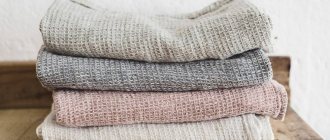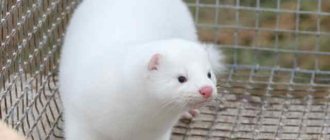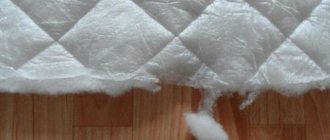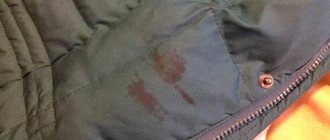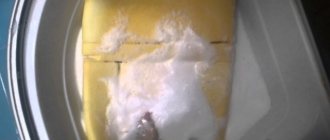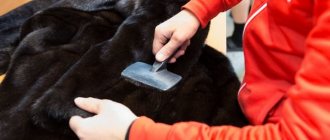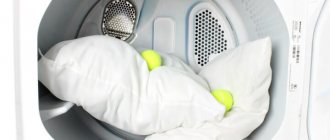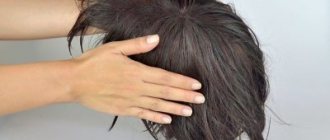Knitted clothing is considered one of the most popular and comfortable to wear. Both adults and children love knitwear for its softness and durability. Cotton, silk, linen, wool, and sometimes synthetic additives are used as raw materials in the production of the material.
In order for your favorite knitted T-shirt to last as long as possible, it is important to follow certain recommendations for caring for the material. Let's figure out how to properly wash knitwear in a washing machine, what detergent to choose and how best to dry the fabric.
Preparatory stage
Before you begin, you need to properly prepare things:
- The clothes are turned inside out.
- Since the bottom of the product and the sleeves can stretch out during wet processing, they should be protected by threading a needle or any other strong and non-fading thread and stitching the problem areas along the edge with wide stitches. Pair the thread only after the product has completely dried.
- Are your clothes stained or heavily soiled? This means that before washing, they soak it - pour cool water into a basin, generously soap the problem areas, and leave for 20 minutes.
- Before washing knitted items, you should carefully study their label: items made from natural fabrics are washed in water at a temperature no higher than 40-50°C, those made from synthetic fabrics - up to 40°C. Do not wash with hot water, as high temperatures may cause the product to shrink.
Reading the label
For many, it will be a “discovery” that manufacturers sew in labels not so that they get in the way and need to be cut off. On this small piece of fabric, the manufacturer places a lot of useful information on caring for the item. If the label says that the item can only be washed at 40 degrees, you should not blame the manufacturer if the clothes stretch or lose their brightness if you wash them in boiling water.
The label is the same instruction manual, so why do we read it for a new phone, but not for a new blouse? After all, the one who sewed this thing is interested in it being worn for a long time, and did everything for this.
Selecting a detergent
It is not recommended to use regular washing powder for washing knitwear - it does not rinse well, and delicate fabric may become damaged after contact with it. Several means are acceptable:
- Soap solution. Laundry soap is rubbed on a fine grater and the shavings are dissolved in water.
- Gel for washing delicate fabrics.
- Shampoo. If you don’t have a special product at hand, you can use any hair shampoo.
- Hard water can deteriorate the appearance of a knitted product; to soften it, use baking soda - about 1 teaspoon will be needed for a medium-sized basin.
- Do not use bleach for knitwear. If it is necessary to make the item white, after washing it, rinse it in water with the addition of a small amount of hydrogen peroxide. A couple of tablespoons of salt or vinegar will help return faded fabric to its rich color - they are dissolved in a bowl of water when rinsing.
Combating the main problem of knitwear – pilling
These unpleasant, unaesthetic and unsightly lumps of lint form on the surface of the material as a result of improper care. Another reason for this rolling may be friction. Often, pellets form on the elbows, in places where a bag or other accessories rub against clothing. It is difficult to combat this phenomenon, but it is possible.
In the “civilized world” they came up with special machines to combat pellets. But our women are not looking for easy ways, so to combat this problem, a variety of means are used - tape, toothpicks and even razors.
Knitted clothing can give a lot of pleasant moments in comfort and aesthetics, but in return it requires careful care and attention. The simple recommendations outlined above will give your clothes longevity.
Handwash
Hand washing is the best way to clean knitted items, since the risk of damaging the product is lower. The process itself is extremely simple:
- A large container is filled with cool water.
- Dissolve a suitable detergent in it, add soda if necessary. Immerse the item in the soap solution and leave for a couple of minutes until the fabric is completely saturated with water.
- Having taken the thing in their hands, they begin to gently squeeze and unclench it with their palms. Movements should go along the product, and not across, otherwise the knitwear may become deformed. You cannot rub the fabric or try to remove stains and heavy dirt with a brush - after this, pellets will form on the knitwear.
- After washing, rinse the item thoroughly, changing the water several times until the soap solution is completely washed out of the fabric. It is important that the rinse water is the same temperature as was used during washing - after contact with colder or hotter water, the product may shrink.
- To make things soft, you can add a teaspoon of glycerin to the water when rinsing.
- You cannot twist the knitwear to try to remove excess water. Before hanging clothes to dry, you need to gently squeeze them with your hands using gentle movements. Start from the top (the neck of a sweater, for example), moving to the bottom.
- Then spread it on a wire rack over the bathtub so that the remaining water drains out. If there is no wire rack, spread a towel on the table, place the washed item on it, roll it up and wring it out. You cannot hang a wet knitwear item on a rope or hanger; the wet fabric will stretch greatly.
How to make it fit the product in a specific place?
Getting something to shrink in the right place is a very difficult task, and with an unguaranteed result.
If the material can be processed with steam, then the following method is suitable:
- Water is poured into an iron with a steam generator.
- Set to maximum heat.
- When ironing, a jet of steam is directed to the place that requires shrinkage.
You can try to place the item in the right place using a hairdryer:
- wash the item or just wet it;
- spread on a horizontal surface;
- set the air regulator to hot air;
- directing a stream of heated air to the part of the item that requires shrinkage, try to gather it with your hands.
By exposing the entire thing to high or, conversely, low temperatures, you cannot be sure that the product will take the shape that is planned.
In the washing machine
Most modern washing machines have a delicate wash cycle. It can also be used to tidy up knitted items, especially if it contains synthetic threads.
Clothes are fastened with all buttons or zippers, if any, and then turned inside out. Before placing items in the drum, it is recommended to place them in a special washing bag - this will protect the fabric from deformation. You should not wash a large number of things at once - when the drum rotates, they can intertwine and stretch out.
Afterwards, set the manual or delicate wash mode, select a water temperature of maximum 40°C, and either turn off the spin cycle completely or reduce the speed to a minimum. Activate an additional rinse cycle. A special gel for washing delicate fabrics or shampoo is added to the detergent compartment.
After removing items from the drum, remove excess water in the same way as after hand washing.
Ironing knitwear
This procedure also contains soy secrets. Iron knitwear only from the inside out, almost without touching the surface with the iron. If there is a need to smooth out frills or frills on the front side, be sure to use a damp cloth or material.
But knitwear’s best friend is a steam generator, which will help keep knitwear in its original form for a very long time.
Decorative items made of leather or fur cannot be washed or ironed at home. Clothing with such decorations should be dry cleaned.
Drying and ironing
Knitted items are dried exclusively in a horizontal position. When the excess water has drained, the item is laid out on a special mesh dryer, carefully straightening it out. Another method is to use a towel laid out on the table. In this case, it will have to be periodically replaced with a fresh one, and the item will have to be turned over to the other side.
Important! During drying, clothing should not be exposed to direct sunlight.
If creases remain on the knitwear after washing, you can iron it. However, you need to remember that products made from thick threads or those with a relief pattern should not be ironed - the knitting will become flat.
The iron is set to minimum heat. Place an ironing iron - a piece of clean cotton fabric - on top of the item laid out on the ironing board; iron only through it. Do not put too much pressure on the device; movements should be light.
If the ironed item turns out to be wrinkled after storing in the closet, you can lightly moisten it with clean water from a spray bottle, lay it out on the table, straighten it thoroughly and leave it for a while. After the moisture has completely evaporated, the folds in the fabric will disappear.
This may be useful: How to wash cotton.
What you need to know about caring for knitwear
The appearance of a new knitwear item in the wardrobe cannot but please both men and women. Even not very fussy children love these soft and comfortable clothes. During the purchase, the sellers promise us that the item will last a long time, will not stretch, will not fade, and will not be deformed. When this all happens after the first few washes, disappointment knows no bounds - you were deceived, poor quality, wasted money. In fact, the person who is to blame for the fact that knitwear quickly loses its appearance is most often not an unscrupulous seller, but a buyer who does not know the basic rules of caring for knitwear.
How to store
You can use various methods to store knitwear. The appropriate one is chosen based on the type and properties of a particular item of clothing.
Thus, products made from thick threads (sweaters) can be folded into a stack and stored in a closet or plastic container. In this case, you need to make sure that things made of denser threads lie at the bottom, and light ones - on top. There is no point in filling a shelf or container completely; it is advisable that air can circulate freely there.
It is convenient to store T-shirts and other fine knitwear items, rolled up, in a dresser drawer. It is not recommended to hang knitted items on hangers. However, if necessary, you can do this so that the products do not stretch. This method is only suitable for sweaters; dresses cannot be stored this way, as they may stretch out:
- the sweater is folded lengthwise so that the sleeves are together;
- placed on a hanger so that there are sleeves on one side and the bottom of the product on the other (see photo).
To store knitted dresses, use only soft hangers, and the hem must be pinned to the area in the armpits - this technique helps to avoid pulling the fabric down.
Despite the fact that when washing knitwear you need to adhere to certain rules, caring for it is not too difficult, and items washed in accordance with the listed recommendations retain their original appearance.
This may be useful: How to wash woolen items.
Jeans
Jeans made from non-Lycra material can be made a little smaller if washed in hot water. It should be taken into account that the shade of the trousers will lighten.
For machine washing the following is installed:
- temperature from 60ºС to 90ºС;
- spin – to maximum;
- automatic drying possible.
This method is not suitable for processing stretch denim fabric, since the lycra included in its composition is not allowed to overheat.
Bleaching knitwear
To maintain the normal appearance and quality of the product, you must follow some rules for washing and bleaching the material. It is important to use only approved products and not experiment, so as not to get disastrous results.
Products for bleaching knitted items:
- One of the most gentle and effective methods of whitening is German salt for stains Sil. Valid at 20°C. Active oxygen removes stains from fruits, red wine, coffee, lipstick. Directions for use: dissolve 50 g of powder in 4 liters. Place the laundry and stir. Leave overnight. Rinse.
- Wet the clothes with water and rub with 72% laundry soap to create a rich, dense foam. Leave to soak for 20 minutes. Water temperature 30-40 °C. Rinse things several times.
- Resuscitate with ammonia. Mix a bottle of ammonia with 10 liters of water at a temperature of 20-30 °C. Place the faded knitted item in the solution for 10 minutes. Wash, rinse twice.
- Use Vanish for white, but with caution. Using a measuring spoon, apply the gel to the stain and rub in with the dispenser. Leave for 10-15 minutes. For soaking, add 100 ml of Vanish to 4 liters of water, water at a temperature of 20-40 °C. Soak for no more than 30 minutes.
- Amway is a universal bleach for all types of fabrics. Dissolve the liquid product in hot water, add cold water until the temperature reaches 30 °C. Soak dirty knitwear overnight. Wash as usual, rinse well.
- With the help of mustard powder you can rid knitwear of grayness and stains. 4 tbsp. Dilute the product in 1 liter of hot water and wait until dissolved. Add cold water so that the temperature is no more than 40 °C. Place the product in the solution, wash after 30 minutes and rinse twice.
ARTICLE FOR YOU
How to properly wash cross stitch at home
For severe stains, when home whitening does not help, seek professional help. In-salon dry cleaning will remove any stains without damaging the fibers of the material.
Read also: What to do with a strawberry mustache?
If you're not afraid to get your hands wet
Knitted items require careful care, so the best option is to wash them by hand. It's longer and more difficult, but much safer. But even when washing by hand, you must follow several rules, focusing on the composition of the fabric and the existing contaminants.
The heating temperature of the water depends on the type and color of the fabric.
- Colored items are cleaned in cold water no higher than 40 degrees. If you exceed the norm, then there is a high chance that the knitwear will fade. To better protect against staining, it is recommended to add 1 tbsp to the soap solution. l. acetic acid.
- Clothes containing wool are washed in water heated to 40-50 degrees. It is important to achieve abundant foam when dissolving the detergent.
- Artificial silk knitwear does not tolerate temperatures above 40 degrees. Ideally – 30-35.
At high temperatures, the knitted product stretches and shrinks, losing its original appearance and shape.
Even in the presence of severe contamination, the water should not be heated above the set value. Knitwear at 50-60 degrees is greatly deformed, shrinks and falls off . Boiling things is prohibited! Cleansing takes place in several stages.
- Clothes are soaked in water for 15-20 minutes.
- For severe contamination, treat the stain with soap concentrate and leave for another 10-15 minutes.
- Afterwards, the fabric is gently compressed and unclenched along its length, which makes it possible to remove contaminants from the fibers.
- Next, the product is rinsed in several approaches.
Hand washing should not take more than half an hour. There is also no need to rub the product vigorously - knitted underwear is surprisingly easy to clean from dirt even in cool water.
Traditional cleaning
If the item's label strictly prohibits machine washing, you will have to clean the item manually. In fact, dirt is easily washed off from knitwear, so the housewife will not have any particular difficulties.
Hand washing is carried out in three stages:
- First, the item is soaked in warm soapy water for 10-20 minutes;
- then stains and dirt are removed with gentle kneading movements;
- then the product is rinsed several times in clean water.
If there is a difficult stain on a knitted sweater, do not wash the item under any circumstances. It is necessary to saturate the stain with a gentle detergent and wait 15 minutes. After this, the jacket is washed in the usual way.
When washing knitwear by hand, you should also follow the basic rules:
- The water temperature should not be higher than 40°C. Ideally – 20-30°C. Hot washing will cause it to lose shape;
- the procedure itself should not exceed 40 minutes - longer contact with water is undesirable for the fabric;
- To avoid loss of brightness of colored items, it is better to pour a spoonful of vinegar into the soap solution. This way the knitwear will not fade.
More precise washing parameters should be found on the product label. For example, the permissible water temperature will be slightly different for knitwear of different compositions. But the general rules for manual cleaning are approximately the same.

